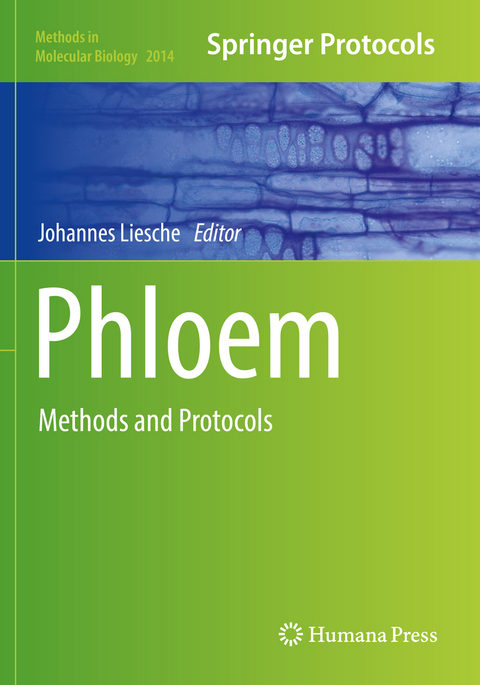
Phloem
Humana Press Inc. (Verlag)
978-1-4939-9564-6 (ISBN)
Authoritative and comprehensive, Phloem: Methods and Protocols is an ideal guide for all researchers exploring this challenging area of plant biology.
Part 1 : Investigating phloem anatomy.- Optimal preparation of tissue sections for light-microscopic analysis of phloem anatomy.- Transmission electron microscopy of the phloem with minimal artifacts.- Scanning electron microscopy of the phloem.- Non-invasive investigation of phloem structure by 3D synchrotron X-ray microtomography.- Quantification of leaf phloem anatomical features with microscopy.- Methods of phloem visualization - a clear future in sight?.- Part 2 : Visualizing phloem proteins.- Super-resolution microscopy of phloem proteins.- Live-cell imaging of fluorescently-tagged phloem proteins with confocal microscopy.- Immunohistochemical localization of proteins in the phloem: problems and solutions.- Part 3 : Sampling phloem sap.- SStudying phloem loading with EDTA-facilitated phloem exudate collection and analysis.- Measurement of inner bark and leaf osmolality.- Using 13C to quantify phloem transport on tall plants in the field .- Non-invasive determination of phloem transport speed with carbon-14 (14C).- Detecting rapid changes in carbon transport and partitioning with carbon-11 (11C).- In vivo veritas: radiotracers in studies of phloem transport of carbohydrate.- Measuring phloem transport velocity in Arabidopsis seedlings using the
fluorescent coumarin glucoside, esculin.- Measuring phloem transport velocity on a tissue-level using a phloem-mobile dye.- Part 4 : Investigating mechanism and quantities of phloem loading and unloading.- Quantification of symplasmic phloem loading capacity with live-cell microscopy.- Assessing Long-distance Carbon Partitioning from Photosynthetic Source Leaves to Heterotrophic Sink Organs with Photoassismilated [14C]CO2.- Measurement of subcellular metabolite concentrations in relation to phloem loading.- Measuring sucrose transporter activity using a protoplast esculin assay.- The AtSUC2 promoter: A powerful tool to study phloem physiology and development.- Part 5 : Phloem physiology.- Using aphids to measure turgor pressure inside sieve elements.- Stem compression: A means to reversibly reduce phloem transport in tree stems.- Methods for assessing the role of phloem transport in plant stress responses.- Part 6 : Theoretical models and microfluidics of phloem function.- Modeling the hydraulic conductivity of phloem sieve elements.- Using a multi-compartmental metabolic model to predict carbon allocation in Arabidopsis thaliana.- A mechanistic model to predict distribution of carbon among multiple sinks.- Using a mathematical model of phloem transport to optimize strategies for crop improvement.- Making microfluidic devices that simulate phloem transport.- Part 7 : Signals in the phloem.- Efficient establishment of interfamily heterograft of Nicotiana benthamiana and Arabidopsis thaliana.- Identification of phloem mobile mRNAs using the Solanacea heterograft system.- Analyzing and predicting phloem mobility of macromolecules with an online database.- Measurement of electropotential waves in intact phloem sieve elements using microelectrodes.- Measurement of electropotential waves in intact sieve elements using aphids as bioelectrodes.- What can cell culture systems reveal about sieve element differentiation?
| Erscheinungsdatum | 07.07.2020 |
|---|---|
| Reihe/Serie | Methods in Molecular Biology ; 2014 |
| Zusatzinfo | 87 Illustrations, color; 20 Illustrations, black and white; XIV, 473 p. 107 illus., 87 illus. in color. |
| Verlagsort | Totowa, NJ |
| Sprache | englisch |
| Maße | 178 x 254 mm |
| Themenwelt | Naturwissenschaften ► Biologie ► Botanik |
| Schlagworte | Carbon isotopes • ecophysiology • molecular processes • Phloem transport • plant development • Plant Physiology • Plant signaling • Theoretical modeling |
| ISBN-10 | 1-4939-9564-2 / 1493995642 |
| ISBN-13 | 978-1-4939-9564-6 / 9781493995646 |
| Zustand | Neuware |
| Haben Sie eine Frage zum Produkt? |
aus dem Bereich


